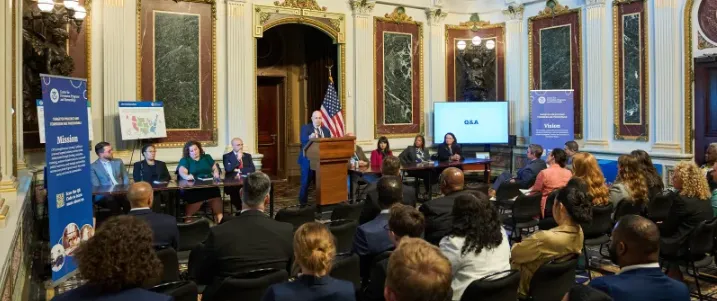
The Homeland Security Act of 2002, drafted in the aftermath of September 11, 2001, provides that the primary mission of the Department of Homeland Security (DHS) includes to “prevent terrorist attacks within the United States.” As we just recently reflected on the 9-11 anniversary, the Center for Prevention Programs and Partnerships (CP3) affirms its commitment to help fulfill the founding mission of the Department.
The CP3 team, led by Director William Braniff, recently briefed the National Security Council on CP3's Approach to Targeted Violence and Terrorism Prevention, highlighting our efforts to prevent targeted violence and terrorism through funding, education, training, evidence-based resources, increased public awareness, and strategic partnerships across every level of government, the private sector, and in local communities.
Tragic attacks in schools, businesses, and community spaces serve as painful reminders that terrorism is not the only form of targeted violence affecting the country. Our approach to targeted violence prevention must work to decrease the likelihood of all forms of violence, including grievance-based violence and hate-fueled violence.
CP3’s approach is based on the principles of violence prevention developed in the public health community over the past three decades. It focuses on increasing protective factors – or strengths – within our communities and classrooms, among peers and families, and with individuals to decrease the likelihood that violence is viewed as a legitimate means of addressing a grievance, expressing hate, or advancing an ideology.

Law enforcement alone cannot address the factors that increase the likelihood of violence – or boost those that decrease the likelihood of violence over time. We need a strong, multidisciplinary approach to protect our communities.
Watch this video to hear CP3’s Director, William Braniff, explain how CP3 enhances the national capacity for targeted violence and terrorism prevention by providing financial resources and technical assistance to grow the prevention provider community of practice. CP3 and its partners create opportunities for interventions that bystanders, schools, workplaces, and communities can pursue when they are concerned about a person's behavior. Law enforcement professionals work with behavioral health specialists, mental health professionals, social workers, and counselors to support individuals in crisis while protecting civil rights and civil liberties.
From our most recent $18M Targeted Violence and Terrorism Prevention (TVTP) Grant funding and evidence-based training to strategic partnerships and awareness raising, CP3 works to support its partners around the nation – violence prevention providers who are creating a culture of targeted violence and terrorism prevention through their efforts. Targeted violence and terrorism are often preventable, and everyone has a role to play in prevention. Learn more about CP3 at DHS.gov/CP3.
